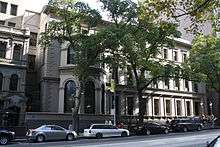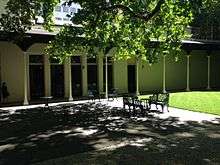Melbourne Club

The Melbourne Club is a private social club established in 1838 and located at 36 Collins Street, Melbourne; adjacent to the Lyceum Club, which is located in Ridgway Place, Melbourne.
The club is a symbol of Australia's British heritage and was established at a gathering of 23 gentlemen on Saturday, 17 December 1838 and initially used John Pascoe Fawkner's public house on the corner of Collins Street and Market Street.[1] The Melbourne Club building is of architectural significance as a rare intact example of a nineteenth-century purpose-built clubhouse in the Victorian Renaissance style.
At the rear of the Club building is a private courtyard garden, maintained by arborist-horticulturalist John Fordham, which is listed on the Victorian Heritage Register,[2] and is the location of garden parties and private functions. The garden contains the largest plane tree in Victoria according to the National Trust's Register of Significant Trees.[2]

Notable members
Frederick Powlett (1811–1865) was a founding member in 1838 as well as being a founding member and the first recorded president of the Melbourne Cricket Club in 1838. He was a public servant, a police magistrate and later chief commissioner of Crown Lands.
Membership included Governors General Sir Isaac Isaacs, Sir Ninian Stephen, Archbishop Peter Hollingworth; Governors of Victoria Sir Henry Winneke, Sir James Gobbo, the Hon Alex Chernov AC; Chief Justices of Australia Sir John Latham, Sir Owen Dixon; High Court Justices Sir Daryl Dawson and Kenneth Madison Hayne AC; Chief Justices of Victoria Sir William Foster Stawell, Sir William Irvine, Sir Frederick Mann, Sir Edmund Herring, Sir Henry Winneke and Sir John Young; Prime Minister Malcolm Fraser, politicians Sir John Bloomfield, Andrew Peacock, Admiral Sir William Bridges; Generals Sir Brudenell White, Sir William Johnston, artists Sir Arthur Streeton and Sir Daryl Lindsay; mining magnates Sir James Balderstone, Hugh Morgan, BHP-Billiton businessman Don Argus, and former head of Shell Australia and vice president of the International Olympic Committee Kevan Gosper.[3]
References
- ↑ McNicoll, Ronald (1988). Number 36 Collins Street (2008 ed.). Australia: Allen & Unwin/Haynes in conjunction with the Melbourne Club. ISBN 978 0 04378 008 4.
- 1 2 Young, Helen (February 20, 2016). "Open gardens: Melbourne Club's walled oasis". The Australian. Retrieved February 21, 2016.
- ↑ "Exclusive clubs feud over highrise plan". ABC Radio. 15 February 2000. Retrieved 24 February 2010.
Coordinates: 37°48′49″S 144°58′21″E / 37.81361°S 144.97250°E